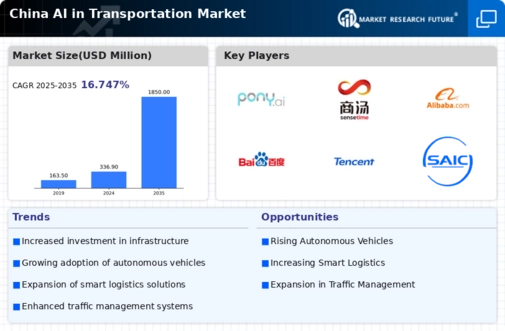Technological Advancements in AI
The continuous advancements in AI technologies are significantly influencing the ai in-transportation market. Innovations in machine learning, computer vision, and data analytics are enabling the development of sophisticated transportation solutions. For instance, AI-powered systems can now process vast amounts of data from various sources, leading to improved decision-making in logistics and traffic management. The market is witnessing a surge in AI applications, with an estimated growth rate of 20% annually in the sector. This technological evolution not only enhances operational efficiency but also contributes to safety improvements in transportation systems. As AI technologies become more accessible, their integration into transportation networks is expected to accelerate, further driving market growth.
Government Initiatives and Support
The Chinese government actively promotes the development of the ai in-transportation market through various initiatives and funding programs. In recent years, substantial investments have been allocated to enhance infrastructure and technology, with the aim of integrating artificial intelligence into transportation systems. For instance, the government has set ambitious targets for the adoption of smart transportation solutions, aiming for a 30% increase in AI-driven public transport systems by 2030. This support not only fosters innovation but also encourages private sector participation, leading to a more robust ecosystem for AI applications in transportation. The collaboration between public and private entities is expected to drive advancements in autonomous vehicles, smart traffic management, and logistics optimization, thereby significantly impacting the overall market landscape.
Urbanization and Population Growth
China's rapid urbanization and population growth are key drivers of the ai in-transportation market. As urban areas expand, the demand for efficient transportation solutions intensifies. The urban population is projected to reach 1 billion by 2030, necessitating innovative approaches to manage traffic congestion and improve public transport systems. AI technologies are increasingly being integrated into urban planning to optimize traffic flow and enhance commuter experiences. For example, AI algorithms can analyze real-time data to adjust traffic signals, potentially reducing congestion by up to 25%. This growing need for smart transportation solutions is likely to propel investments in AI technologies, creating a favorable environment for the development of the market.
Environmental Concerns and Sustainability
Growing environmental concerns are pushing the ai in-transportation market towards more sustainable practices. The Chinese government has set ambitious goals to reduce carbon emissions, aiming for a 40% reduction by 2030. AI technologies play a crucial role in achieving these targets by optimizing routes, reducing fuel consumption, and enhancing the efficiency of public transport systems. For example, AI-driven analytics can identify the most efficient routes for delivery vehicles, potentially decreasing emissions by 15%. This shift towards sustainability is likely to increase the adoption of AI solutions in transportation, as companies seek to align with regulatory requirements and consumer preferences for greener alternatives.
Rising Demand for Smart Logistics Solutions
The increasing complexity of supply chains in China is driving the demand for smart logistics solutions within the ai in-transportation market. As e-commerce continues to expand, companies are seeking innovative ways to enhance their logistics operations. AI technologies are being utilized to streamline processes, improve inventory management, and optimize delivery routes. The market for AI in logistics is expected to grow by 25% over the next five years, reflecting the urgent need for efficiency in transportation networks. By leveraging AI, businesses can reduce operational costs and improve service delivery, thereby gaining a competitive edge in the rapidly evolving market landscape.





















Leave a Comment